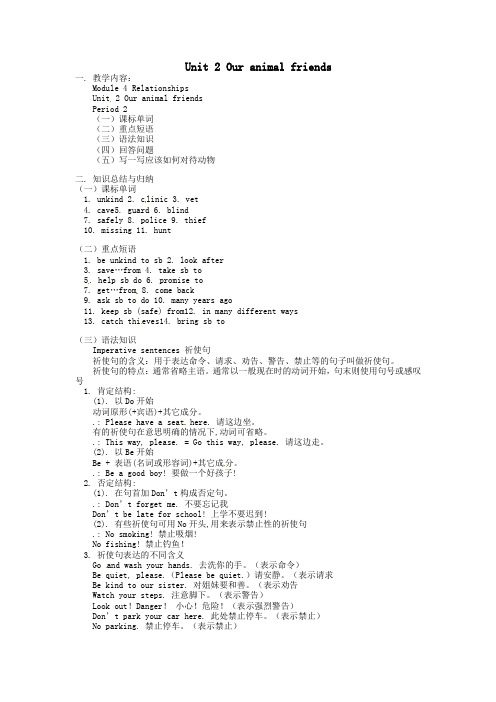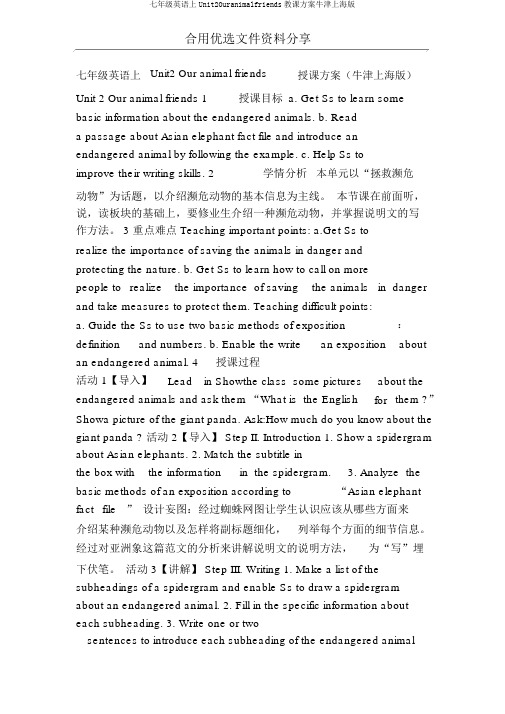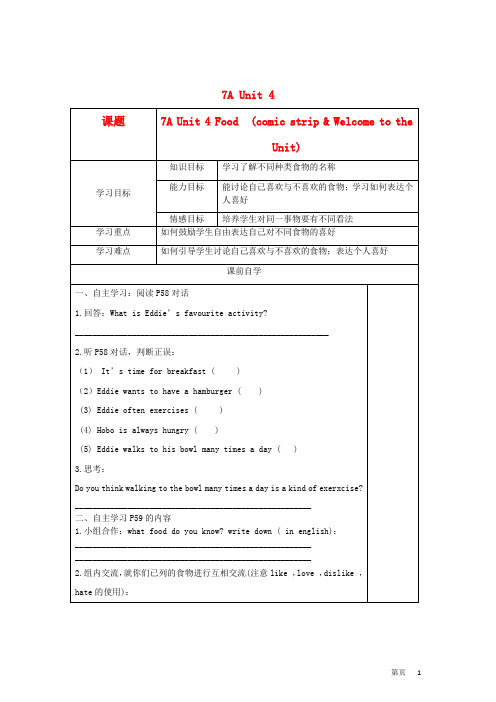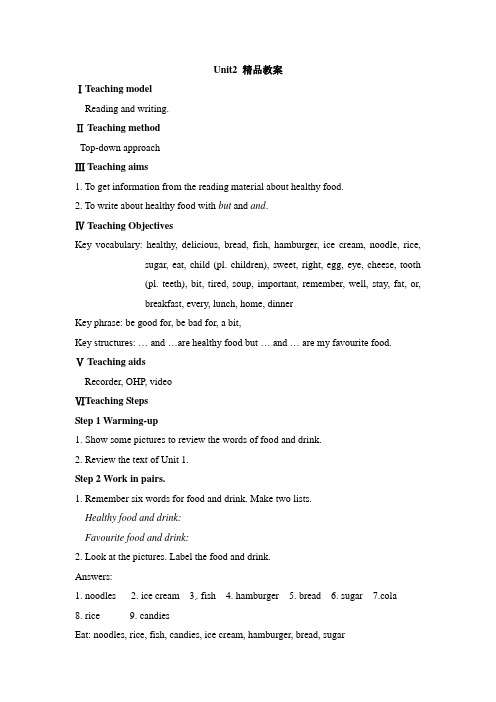七年级英语上册Module4Unit2Ouranimalfriends教案上海牛津版
- 格式:doc
- 大小:34.00 KB
- 文档页数:3

Unit 2 Our animal friends一. 教学内容:Module 4 RelationshipsUnit 2 Our animal friendsPeriod 2(一)课标单词(二)重点短语(三)语法知识(四)回答问题(五)写一写应该如何对待动物二. 知识总结与归纳(一)课标单词1. unkind2. c linic3. vet4. cave5. guard6. blind7. safely 8. police 9. thief10. missing 11. hunt(二)重点短语1. be unkind to sb2. look after3. save…from4. take sb to5. help sb do6. promise to7. get…from 8. come back9. ask sb to do 10. many years ago11. keep sb (safe) from12. in many different ways13. catch thi eves14. bring sb to(三)语法知识Imperative sentences 祈使句祈使句的含义:用于表达命令、请求、劝告、警告、禁止等的句子叫做祈使句。
祈使句的特点:通常省略主语。
通常以一般现在时的动词开始,句末则使用句号或感叹号1. 肯定结构:(1). 以Do开始动词原形(+宾语)+其它成分。
.: Please have a seat here. 请这边坐。
有的祈使句在意思明确的情况下,动词可省略。
.: This way, please. = Go this way, please. 请这边走。
(2). 以Be开始Be + 表语(名词或形容词)+其它成分。
.: Be a good boy! 要做一个好孩子!2. 否定结构:(1). 在句首加Don’t构成否定句。
.: Don’t forget me. 不要忘记我Don’t be late for school! 上学不要迟到!(2). 有些祈使句可用No开头,用来表示禁止性的祈使句.: No smoking! 禁止吸烟!No fishing! 禁止钓鱼!3. 祈使句表达的不同含义Go and wash your hands. 去洗你的手。

合用优选文件资料分享七年级英语上Unit2 Our animal friends授课方案(牛津上海版)Unit 2 Our animal friends 1授课目标a. Get Ss to learn somebasic information about the endangered animals. b. Reada passage about Asian elephant fact file and introduce anendangered animal by following the example. c. Help Ss toimprove their writing skills. 2学情分析本单元以“拯救濒危动物”为话题,以介绍濒危动物的基本信息为主线。
本节课在前面听,说,读板块的基础上,要修业生介绍一种濒危动物,并掌握说明文的写作方法。
3 重点难点 Teaching important points: a.Get Ss torealize the importance of saving the animals in danger andprotecting the nature. b. Get Ss to learn how to call on morepeople to realize the importance of saving the animals in danger and take measures to protect them. Teaching difficult points:a. Guide the Ss to use two basic methods of exposition:definition and numbers.b. Enable the write an exposition about an endangered animal. 4授课过程活动 1【导入】Lead in Showthe class some pictures about the endangered animals and ask them “What is the English for them ?”Showa picture of the giant panda. Ask:How much do you know about the giant panda ? 活动 2【导入】 Step II. Introduction 1. Show a spidergram about Asian elephants. 2. Match the subtitle inthe box with the information in the spidergram. 3. Analyze the basic methods of an exposition according to“Asian elephant fact file” 设计妄图:经过蜘蛛网图让学生认识应该从哪些方面来介绍某种濒危动物以及怎样将副标题细化,列举每个方面的细节信息。


7A Unit 4学习目标知识目标掌握频率副词及相关句型,可数名词和不可数名词的用法及可数名词复数变化规则能力目标认识并使用频率副词;识别并使用可数和不可数名词及冠词情感目标学习重点频率副词,可数名词和不可数名词的用法及可数名词复数变化规则学习难点不可数名词的用法及可数名词复数变化规则课前自学一、你还记得这些词吗?写出它们的英文意思:可乐()巧克力()茶()柠檬()牛奶()胡萝卜()芒果()月饼()西红柿()果汁()牛肉()鱼()猪肉()卷心菜()水果()甜食()二、查资料1.理解定义:频率:____________________________________2.频率副词有:_____________________________________三、读一读Millie家一周的dinner图表,完成下列任务Sun Mon Tue Wed Thur Fri Sat√√√√√√√√√√√√√√√√√√√√√√0√ 1-2√ 3√ 4√ 5-6√ 7√never seldom sometimes often usuallyalways1. They ____________have fish for dinner.2. They ____________eat rice for dinner.3. They ____________eat vegetables for dinner.4. They ____________ have soup for dinner.5. They _____________have hamburgers for dinner.四、完成P64的练习。
五、自学P65-66内容。
理解以下内容:a.冠词有:________, _______,_______参考答案7A Unit 47A Unit 4 Food (comic strip & Welcome to the Unit)课前自学一、自主学习:阅读P58对话1.walk to his bowl many times a day2. ×√××√课堂交流展示二、学习 Welcome to the Unit部分3. bananas ,carrots , fish, eggs , hamburgers , carrots , eggs课堂达标检测一、给这些食物分类.Vegetables: carrots ,tomatoes ,vegetables Fruit: apples, orange Meat: chicken , fish ,pork , beefDrink: milk others:hamburger, cakes,eggs, mooncakes ,, chocolate , rice二、翻译下列句子.(一空一词).1.food do you like2. don’t playing basketball what about you3. time for4. three times5. never needs ,energy7A Unit 4 Food (Reading(1))课前自学一、读课文,完成下列任务:2. years, wants ,dancer ,for , healthy diet ,dancer, fit/ healthy Energy, seldom ,sugar二、再读课文,在文中找出这些短语,并把它们和下面的汉语对应起来。

Module 4 Healthy foodUnit 2 Is your food and drink healthy?单词delicious ,hamburger, sugar, sweet,1、学会用but和and来描述自己最喜欢的食物学会用but和and来描述食物。
StepⅠWarming upTalk in pairs : What is your favorite food, fruit, and vegetables, which is healthy and which is not healthy?Step ⅡPre-readingTask 1: Finish Activity1—2(先独立完成,再小组讨论)【温馨提示】根据活动要求完成任务,任务很简单,同学们一定要积极参与Task 2 :Close your books and listen to Activity3 and say “What is Healthy food and drink?”【温馨提示】这是锻炼你们听力的好机会,你们要认真听哟!Task 3 : Finish Activity3(先独立完成,然后结对练习)【温馨提示】小组间展开竞争,看哪一组最棒。
Step ⅢWhile-reading自读短文并能按以下导词进行复述:Noodles and rice are …but too much meat is not… … are sweet and too much sugar is … you. Eat the … food and be … … are good for your eyes, …are good for your teeth.. Have a lot of …when you are a bit tired. It’s important to remember…【温馨提示】学生先跟读课文,纠正语音,语调,解决里面的生词,然后自读课文,接着教师领述,最后学生试着自己练习复述,并小组展示。

Unit2 精品教案ⅠTeaching modelReading and writing.Ⅱ Teaching methodTop-down approachⅢ Teaching aims1. To get information from the reading material about healthy food.2. To write about healthy food with but and and.Ⅳ Teaching ObjectivesKey vocabulary: healthy, delicious, bread, fish, hamburger, ice cream, noodle, rice, sugar, eat, child (pl. children), sweet, right, egg, eye, cheese, tooth(pl. teeth), bit, tired, soup, important, remember, well, stay, fat, or,breakfast, every, lunch, home, dinnerKey phrase: be good for, be bad for, a bit,Key structures: … and …are healthy food but … and … are my favourite food.Ⅴ Teaching aidsRecorder, OHP, videoⅥTeaching StepsStep 1 Warming-up1. Show some pictures to review the words of food and drink.2. Review the text of Unit 1.Step 2 Work in pairs.1. Remember six words for food and drink. Make two lists.Healthy food and drink:Favourite food and drink:2. Look at the pictures. Label the food and drink.Answers:1. noodles2. ice cream3. fish4. hamburger5. bread6. sugar7.cola8. rice 9. candiesEat: noodles, rice, fish, candies, ice cream, hamburger, bread, sugarDrink: cola3. Call back the answers from the whole class.4. Read the words after the teacher.Step 3 Reading.1. Play the recording.2. Ask the students to read through the passage.3. Read the passage and complete the table.4. Check with a partner.5. Call back the answers from the whole class.Keys:1. Healthy food and drink: meat, carrots, eggs, potatoes, milk, cheese, fish, chicken, noodles, rice, juice, water, tea, fruit, vegetables2. Not healthy food and drink: ice cream, hamburgers, cola, candyStep 4 Do exercises.1. Ask the students to read through the passage in Activity 4.2. Complete the passage with the correct from of the words and expression from the box.3. Check with a partner.4. Call back the answers from the whole class.5. Read the passage together.Step 5 Work in pairs.1. Ask the students to choose food from Units 1 and 2 for their meals.2. Talk about their answers like this:1) What’s your favourite food and drink?2) Is it healthy food and drink?Step 6 Writing.1. Join the sentences with but.1) Juice is a healthy drink. Cola isn’t a healthy drink.2) Noodles are healthy food. Hamburgers aren’t healthy food..3) Meat, vegetables and fruit are healthy food. Cola, ice cream and hamburgers aren’thealthy food and drink.4) Chocolate is delicious. Too much chocolate isn’t good for you.2. Check with a partner.3. Call back the answers from the whole class.4. Complete the sentence about you.… and …are healthy food but … and … are my favourite food.Step 7 Important and difficult points.A.重点短语:1. have/has got 拥有2. go shopping 去买东西;去购物3. let’s do sth. 让我们去做某事4. too much 太多5. too many 太多6. lots of 许多7. be good for 对……有益8. be bad for 对……有害9. How about… ? ……好吗?……行吗?B. 重要知识点:可数名词的特殊变化:1.child—children 孩子2. tooth—teeth牙齿连词and, or, but 的区别:1.and:表示“和,又,与,并”,连接两个名词、动词或句子,表示并列关系。
【优选】人教版七年级上册英语Unit4第四单元优秀教案简介本教案旨在帮助七年级学生研究人教版英语上册第四单元的内容。
通过本教案的引导和练,学生将能够更好地掌握单元中的词汇、语法和听力技巧。
教学目标- 了解单元的主题和内容- 研究并掌握本单元的重点词汇和短语- 掌握并运用本单元的语法知识- 提高听力技能,能够听懂并理解与本单元相关的对话和文章教学准备- 人教版七年级上册英语教材- 教师课件或黑板、白板- 学生练册和作业本- 录音设备或电脑播放器教学步骤步骤一:引入新单元1. 利用图片、视频或简短的对话引入新单元的主题,并与学生进行互动交流。
2. 提出几个问题,引导学生思考与本单元相关的话题,并鼓励他们用英语表达自己的观点和想法。
步骤二:研究词汇和短语1. 引导学生通过教材中提供的词汇表,研究本单元的重点词汇和短语。
2. 进行词汇练活动,如听写、填空或配对练,以帮助学生巩固词汇记忆和拓展词汇运用能力。
步骤三:研究语法知识1. 介绍并讲解本单元的语法知识点,如简单现在时的用法或名词的复数形式等。
2. 进行语法练活动,如填空、改错或翻译练,以帮助学生掌握和运用语法知识。
步骤四:提高听力技能1. 播放与本单元相关的录音材料,如对话或短文,并提供听力理解题目。
2. 让学生跟读录音材料,以帮助他们提高听力技能和语音表达能力。
步骤五:巩固和练1. 分发练册或作业本上的相关练题,让学生进行独立或小组完成。
2. 监督学生完成练,并提供必要的指导和反馈。
步骤六:总结和复1. 回顾本单元的主要内容和研究成果。
2. 进行小结性的问答或讨论活动,帮助学生巩固对本单元的理解和记忆。
教学评估- 观察学生在课堂活动中的参与程度和表现- 收集并批改学生完成的练和作业- 进行口头测试或小测验,评估学生对本单元知识的掌握情况教学延伸- 鼓励学生进行口语对话练,以提高他们的口语交流能力- 制作课堂展示活动,让学生展示他们对本单元内容的理解和研究成果参考资源- 人教版七年级上册英语教材和练册- 相关英语学习网站和应用程序。
Unit4 Section A2a-2d一、教学目标:(一)知识目标掌握本课生词,学习谈论物品的位置Where is/are…?It’s/They’re…。
(二)能力目标让学生学会如何听和谈论物品的位置。
(三)情感目标1. 培养学生良好的合作意识,鼓励学生大胆表达自己的想法和意愿。
2. 通过谈论物品的位置,培养学生养成良好的生活习惯。
Step1 Leading in1.Greeting to the class.2.show the students the objectivesTo learn to talk about where things areTo learn new words: come, desk, think, room, their, hat, head…3.Review the Words and expressionsStep2 Presentationing PPT to present and review the wordsand phrases.2. Using PPT to help Ss to make up conversations and correc their mistakes .Ask the students to ask the positionsUsing the expressionsWhere’s/Where’re…It is/ It’s They are /They are…Step3 Listening practiceThrough the PPT to play,.Ask the Ss. to listen carefuly, and finish some tasks in 2a and 2b. Then ask someone to check the answers.Step 4 Presentation and Pairwork1.Present some new sentence forms .2.Show Ss. Some pictures,on the Screen ,let Ss. make someconversations in pairs.ing PPT to help Ss to Improve their speaking skills . Step 5 ReadingAsk Ss to read the dialogue in 2d and match the right things. Then ask someone to check the answers.Step 6 Presentation and Practice1.Give some explanation about the dialogue in 2d.2.Note the main expressions. Help the Ss to understander thesentences.3.Ask the Ss to listen to the and try to learn it by heart.4. Ask two Ss to role play the dialogueStep 7 SummaryHave a summary on the Bd. Make sure Ss can master.1.谈论物品的位置Where be+ 主语? 主语+be+介词短语Be+主+介词短语?Yes,主+be. No,主+be+not.2.否定式be+not3.名词所有格的构成:+‘s/s结尾的+‘4. I +think + that从句Step 8 HomeworkFinish some exercises in the exercisebook.。
课时备课学情分析1.知识经验(1)已有知识经验学生之前已经学习have/has got 的基本用法,并能熟练运用,学生对食物的话题也非常熟悉。
这就对本模块的学习奠定了良好的知识基础。
(2)未学知识Any/some 的正确用法(3)障碍点可数名词复数的变化规律及读音。
(4)个性化目标有的学生对于have/has got的陈述句、一般疑问句和特殊疑问句的用法不能熟练应用。
优生能够灵活运用所学句型,差生能够对课文中重点句型熟记。
2.生活经验已有生活经验: 饮食和购物话题,学生们非常熟悉,有大量的生活经验。
(1)未有生活经验:用英语语言进行日常交流。
学生尝试看着音标自己练习读新单词:free 1.Free talk:Healthy food and drink:Unhealthy food and drink:Your favourite food and drink2.匹配单词,并按要求分类。
(对应目标1)分类,并初步讨论是否有利于健康。
4.小组展示分类结果有利健康拨。
活动三:活动三:分层阅读。
(对应目标2)【文章阅读】快速阅读完成题目。
一读Read the text and complete the table.Healthy food and drink Unhealthy food and drinkDeep reading完成题目二读 1.Read the first paragraph and check T or F.(1) Ice cream is unhealthy.( )(2) Meat is unhealthy.( )(3) Too much meat is bad for children. ( )(4) Sweet food is good for people.( )2.Read the second paragraph and answer thequestions.(1)What kind of food should we eat?1.学生先看文章,并能快速将食物、饮料分类。
Module 4 Unit 2 Our animal friends
【本讲教育信息】
一. 教学内容:
Module 2 Relationships Unit 2 Our animal friends
(一)课标词汇
(二)重点短语
(三)重点句型
(四)一般现在时、一般过去时的用法
二. 知识总结与归纳:
(一)课标词汇
1. animal
2. fun
3. speak
4. rescue
5. farm
6. hungry
7. thirsty
8. nobody
9. prefer 10. best 11. light 12. call
13. well 14. if 15. tell 16. complete
17. problem 18. choose 19. family 20. mean
21. danger 22. find 23. become 24. try
25. accident 26. many 27. sometimes 28. die 29. promise 30. cat 31. care 32. street
33. address 34. keep 35. own 36. ask
37.
example 38.newspaper
39. police 40. catch
41. robber 42. lose 43. hunt 44. blind
45. person 46. safe 47. safely 48. sheep
(二)重点短语
1. look after
2. care for
3. take care of
4. bring…to
5. family name
6. tell sb. how to do
7. sick animals
8. every year
9. be cruel to
10. be kind to
11. promise to
12. for example
13. in many ways
14. millions of
15. on their farm
(三)重点句型
1. Which one would you like?
2. I prefer the black one.
3. You must look him well.
4. Let’s call him Sam.
5. What does SPCA mean?
6. Thank you for coming to visit SPCA.
7. The dog ate the meat, too.
(四)一般现在时、一般过去时的用法
一般现在时
一般现在时表示现在的状态
如:He is twelve.
She is at work.
表示经常的或习惯性的动作
如:I get up at 6:30 every day.
表示主语具备的性格和能力等
如: She likes noodles.
They speak French.
如果谓语动词是be 动词,则根据主语选择相应的am, is, are。
如:I am a teacher. She is a girl. They are very nice.
如果谓语为实意动词,主语为第一人称,第二人称和第三人称复数时动词用原形,主语为第三人称单数时,动词用相应的第三人称单数形式。
如:They help me. You speak English. He goes to school on foot.
一般过去时
一般过去时表示过去某个时间发生的动作或存在的状态,常和表示过去的时间状语连用,如yesterday, last night, in 1990, two days ago 等。
也表示过去经常或反复发生的动作,常和often, always 等表示频度的时间状语连用。
例如:I got up at 6:30 yesterday.
My father was at work yesterday afternoon.
He always went to work by bus last year.。